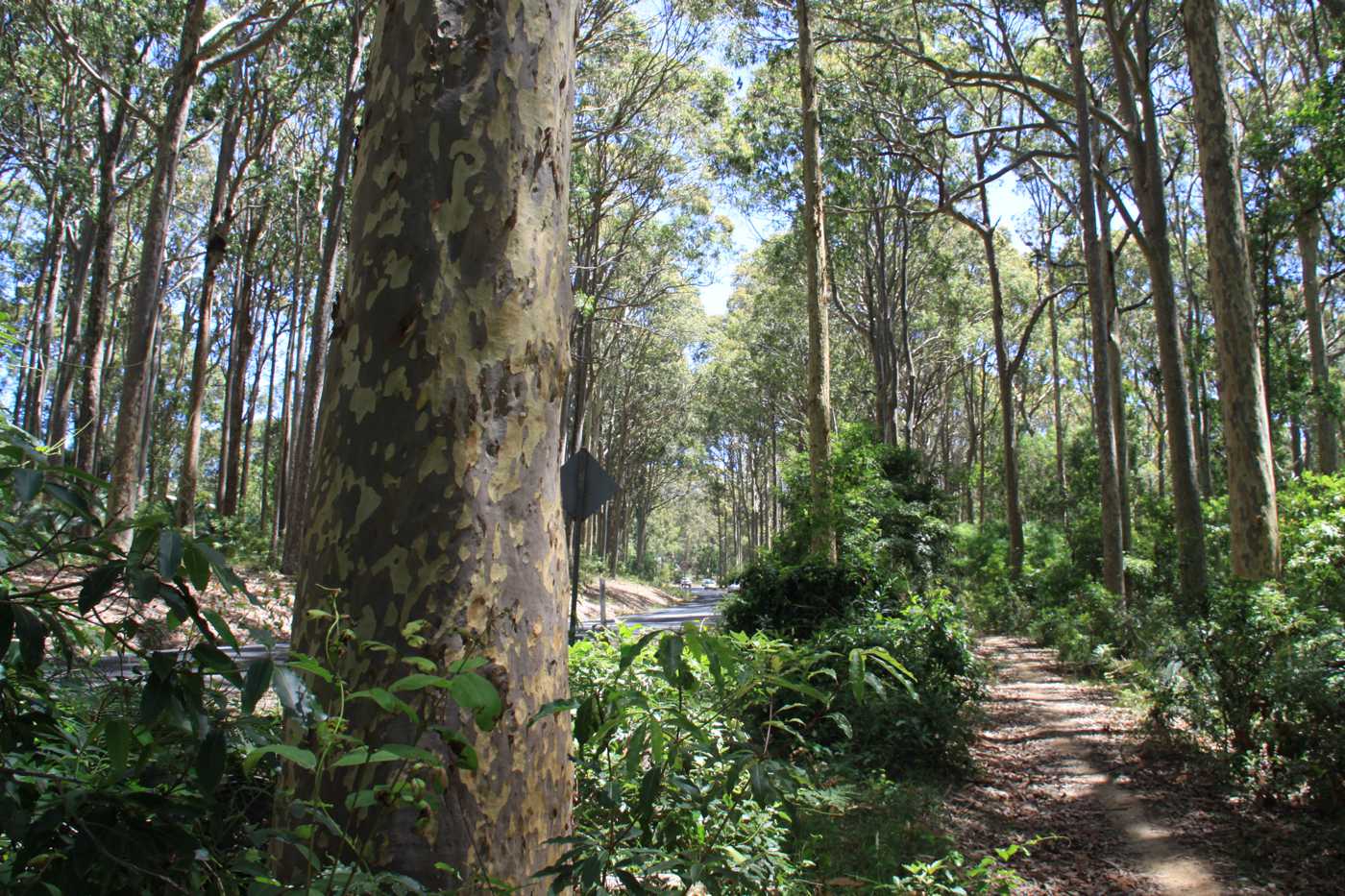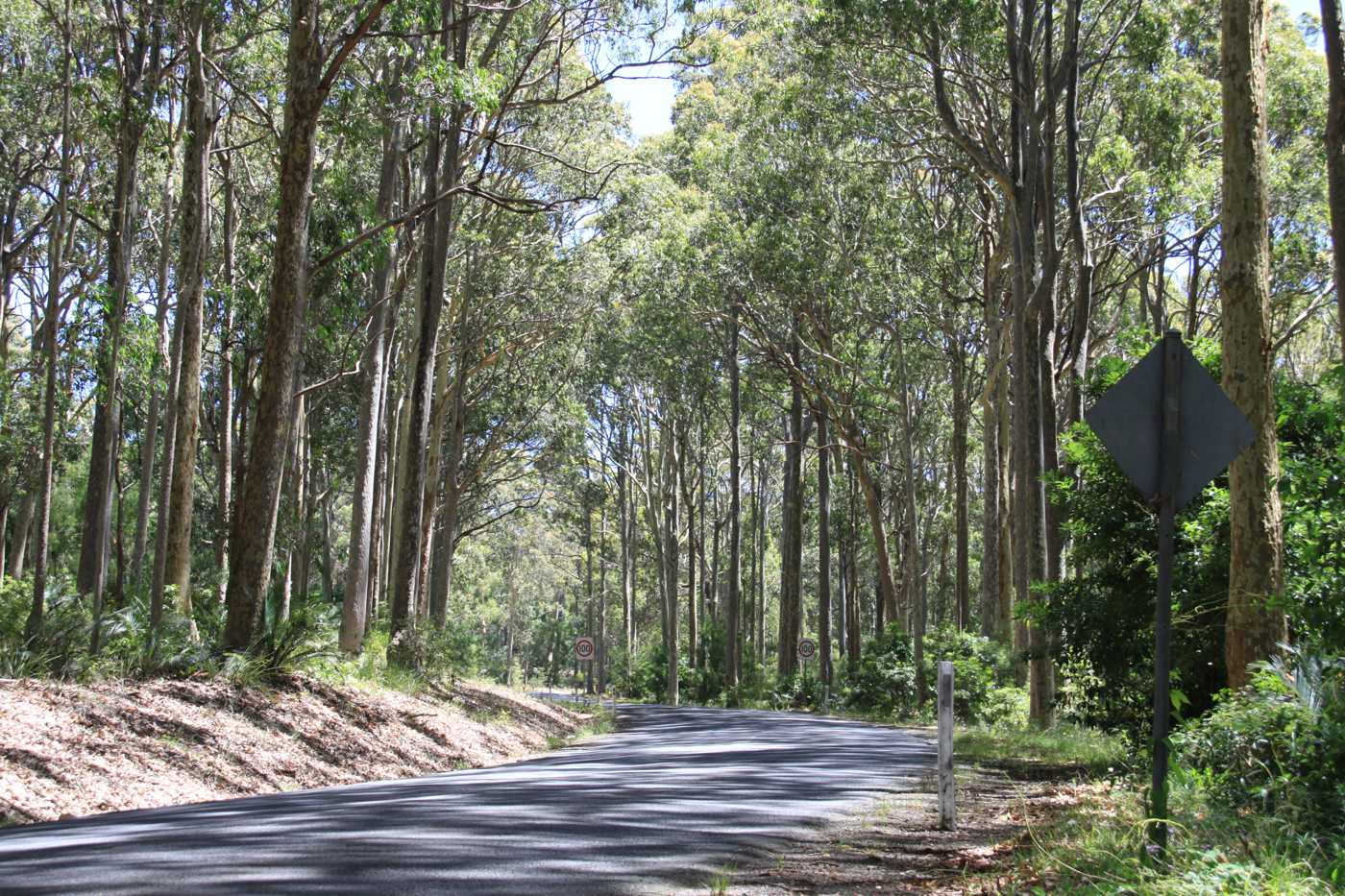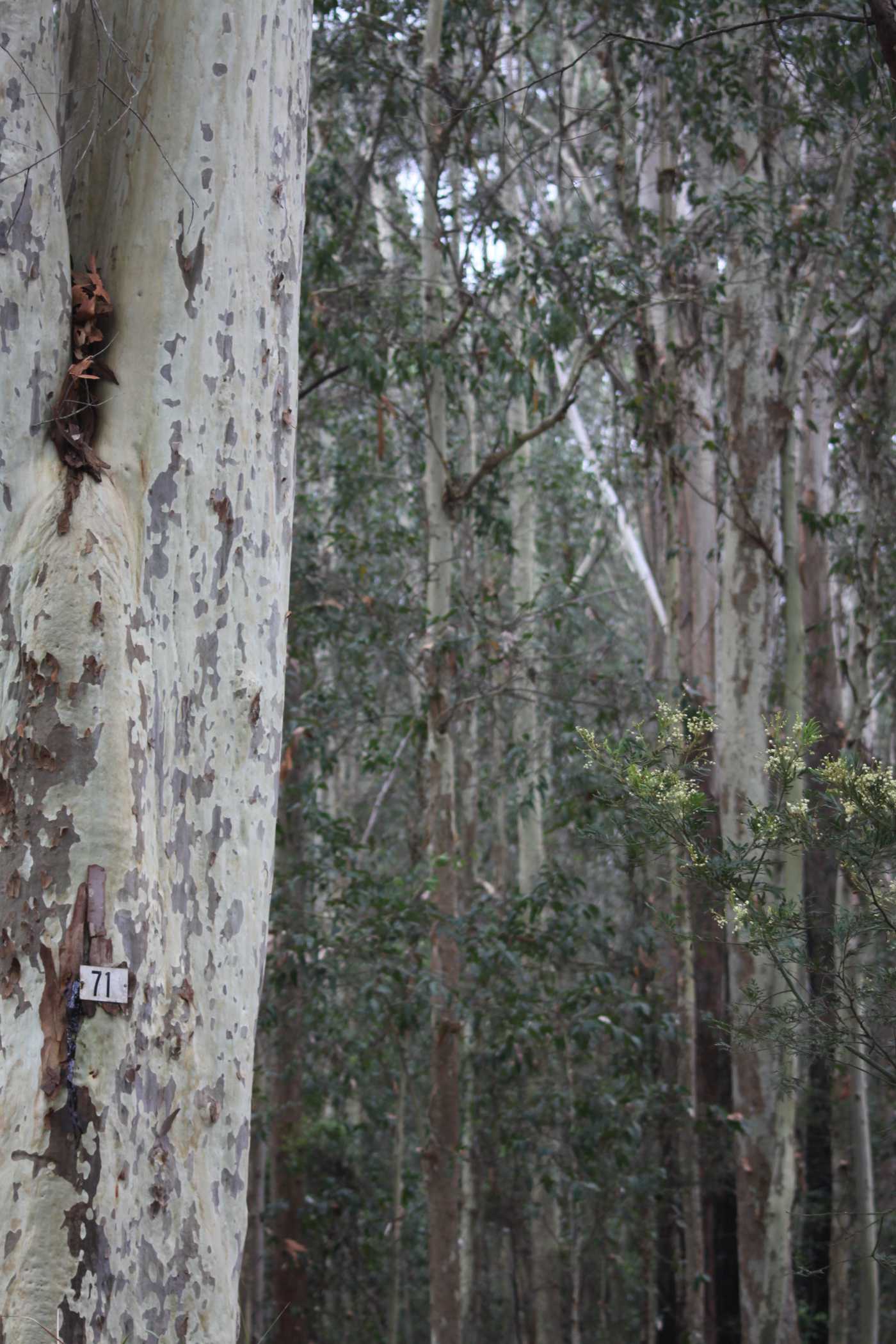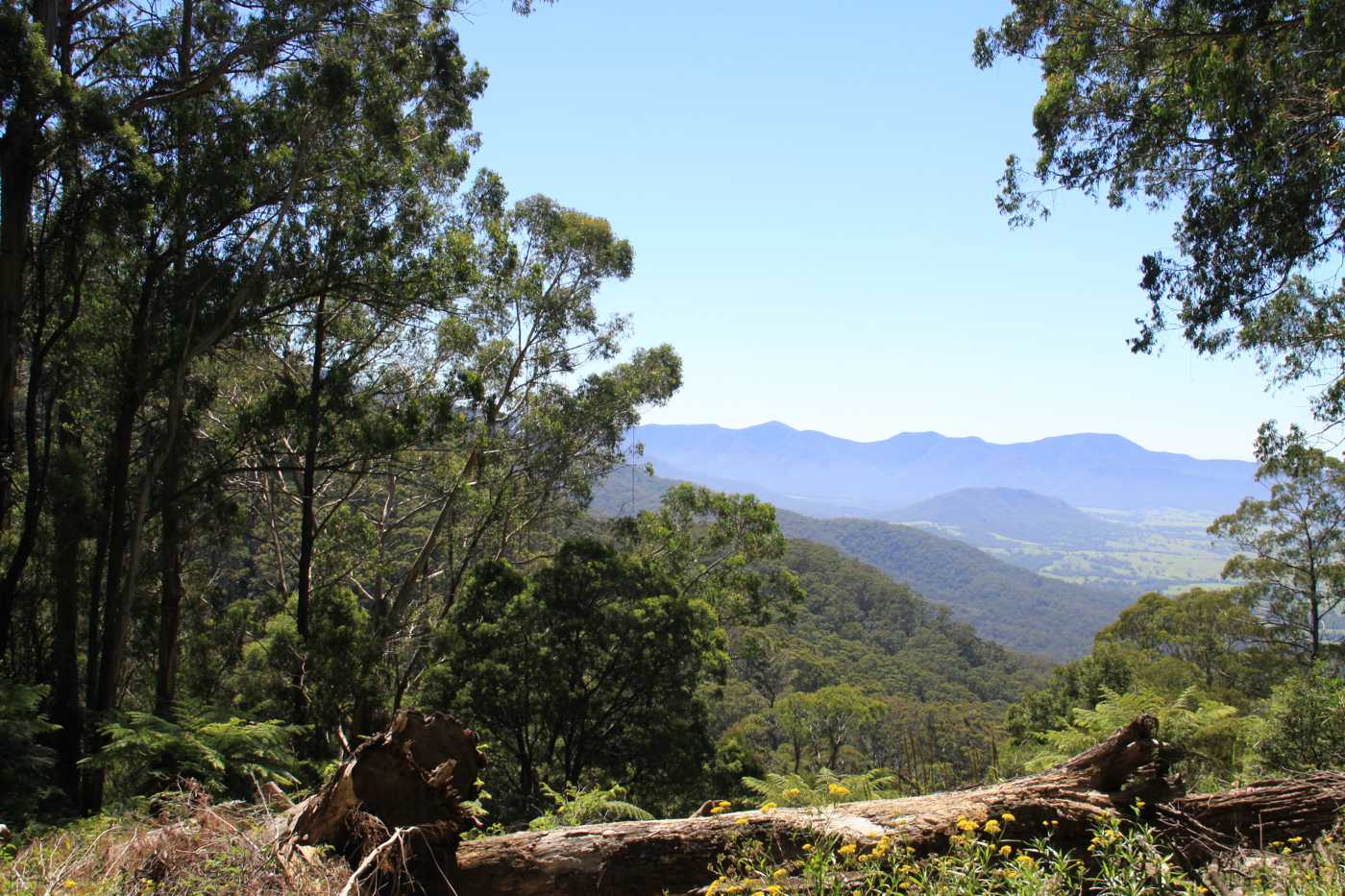Since early morning I’ve been driving across the Gippsland plain in my van. I’m on my way to Tanja on the south coast of New South Wales, from Melbourne where I’ve recently moved. The Princes Highway cuts a straight path through this region, across undulating farmland. It is all cows and grass, with only scattered paddock trees and the odd remnant stand of roadside red gum. In a moment, the yellow light of the farmland gives way to filtered greens. I’ve been on the road for close to five hours and have just entered the southeast corner bioregion. On the map it’s a large green mass, spanning south-east New South Wales and north-east Victoria. This is a vast forest, uniquely intact, connecting the coastal heaths to alpine meadows hundreds of kilometres away.
Just out of Tanja the road begins to wind, through tall Spotted Gum forest and Burrawang Cycads. After a while I register that my cheeks have started to ache. I notice I’ve been smiling away, alone in my van, since entering the forest and my mouth cracks into an even wider grin. I’m struck by how much I am affected, simply because I am surrounded by trees. It’s a bittersweet feeling, like finding something precious I didn’t know I’d lost. I’m suddenly aware that the life I’ve been making in Melbourne has been deficient of one very important thing: a connection to nature.


The same Spotted Gums grow around my childhood home. At the northern extent of the bioregion, our property edges onto Morton National Park. Growing up on the edge of this forest, I spent my days scratching up my legs in the Blady Grass and scrambling up Black Wattles (Spotted Gums are dead straight and useless for climbing), one arm usually clutching a beloved and tolerant pet chicken. Wildlife encounters were ubiquitous, even in my bedroom. This was a giant octagonal building, constructed by my dad from repurposed ironbark sleepers. The sleepers, having shrunk slightly since instalment, had small gaps between them, and so my walls were a semi-permeable membrane to the outside world. Most nights wombats would thud around underneath the floor, their shufflings familiar and comforting. Antechinus would frequent my room at all hours, and were particularly amusing when observed in the day, tugging tenaciously at the corner of a rug, completely unfazed by the curious child watching a metre away. These same antechinus would get themselves into obvious digestive strife by sampling the odd custard tart left out in the kitchen.
As I grew, I began to build an understanding of my surroundings which seemed to differentiate me from my friends in town. Snakes and spiders and leaches were not scary. The bush was an extension of what it meant to be home. It was where I felt most at ease, but was also endlessly fascinating and amusing. A favourite game was to pick blue objects from the house; magnets, straws, string and leave them outside on the table. The following morning when I found my offerings decorating the shaded arbour of a Satin Bowerbird, a glow of satisfaction would stay with me all day.
The delight and comfort I felt in my surrounds as a kid grew to intrigue and a keenness to study. I left home for a science degree at Wollongong University. Wollongong’s suburbs are sandwiched between omnipresent sandstone cliffs and the Pacific Ocean. Life was about flinging yourself into that ocean, on a board or floating in a sea pool, staring up at that escarpment. In the southern suburbs, Sulphur-crested Cockatoos would leave the forested slopes in the morning, fanning their way out in huge raucous drifts, and returning like clockwork on twilight to roost, tearing up verandas and decks in their path.

To the north, the spit of land between the escarpment and the ocean is precipitously narrow. Up there, the landscape felt wild and prehistoric. The haunting calls of Yellow-tailed Black Cockatoos and Green Catbirds drifted across the slowly gentrifying suburbs and rolling rainforest hills. Many sessions at the Headlands Hotel peaked as we watched processions of Humpback Whales breaching against a backdrop of pinks and oranges as the sun set. What became the important places of my twenties have names like Burning Palms, Fairy Meadow, Sublime Point. Evocative and reverent of nature.
After eight years in Wollongong, I moved to Melbourne to start a PhD. Within a few weeks, I happily discovered the Merri Creek and Yarra trails and have treasured them ever since. I knew I would need them. I was well aware that spending time in green spaces has a positive effect on mental and physical health. I was pretty sure both would be challenged by the slog of relentless study. Still, I threw myself into enjoying what Melbourne has to offer. I found it’s not just reliably good coffee and bars. For me, Melbourne is all about diversity, choice, inclusivity, community. All things to embrace. However, that morning driving through the forest it struck me that feeling connected to nature is intrinsic to my essential wellbeing. And it’s something I can’t ignore or substitute. This may sound like a fairly obvious observation to make given my background, but in the past being in nature was not something I had to think about, much less prioritise.
With this newfound awareness of self, I’ve discovered another great thing about Melbourne. The city is accessible to an incredible diversity of ecosystems. A short drive can have you revelling among the tree ferns and sentinel Mountain Ashes in the Dandenongs or hiking the snow-covered Mount Baw Baw. A longer trip can have you searching for the fabled white wombats of Wilsons Prom, or staring down at an Owlet Nightjar secreted inside the hollow of a Little Desert mallee. I will make sure I enjoy such experiences along with the good coffee, until the Southeast Corner calls me home.


Leave a Reply